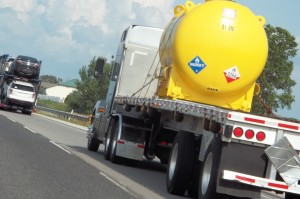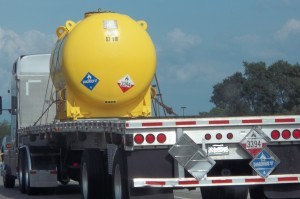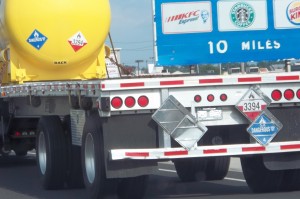When traveling you may wonder about the potential hazards of the HazMat you see transported on our nation’s highways. Fortunately the Hazardous Material Regulations (HMR) of the Pipeline and Hazardous Materials Safety Administration (aka: PHMSA, one of many transportation-related administrations within the US Department of Transportation) require both Shippers and Carriers of HazMat to ensure it is transported in commerce safely and in a manner that communicates the potential hazards of the material. The purpose of this article is to take one example of HazMat in transportation and decipher the meaning of the hazard communication methods in use. The content of this article is based on the visible elements of the images in this article and my knowledge of the HMR.
Let’s start with the packaging. As defined by PHMSA regulations at 49 CFR 171.8, the yellow tank secured to the flat bed of the motor vehicle is a portable tank:
Portable tank means a bulk packaging (except a cylinder having a water capacity of 1000 pounds or less) designed primarily to be loaded onto, or on, or temporarily attached to a transport vehicle or ship and equipped with skids, mountings, or accessories to facilitate handling of the tank by mechanical means. It does not include a cargo tank, tank car, multi-unit tank car tank, or trailer carrying 3AX, 3AAX, or 3T cylinders.
A portable tank, therefore, is a bulk packaging (>119 gallon maximum capacity for a liquid) that is not a permanent part of the vehicle. It is intended to be unloaded from the vehicle by mechanical means upon arriving at its destination. This differs from a cargo tank which is permanently attached to the vehicle.
|
Like this article? Subscribe to my Monthly Newsletter No marketing emails! |
Further – and I’m stretching the limits of the available information here – but I believe it to be a UN portable tank based on the authorized packaging requirements of 49 CFR 173.244 as referenced from Column 8C of the Hazardous Materials Table at 49 CFR 172.201. (The purpose of Column 8b of the Hazardous Materials Table is to indicate what bulk packaging is authorized for the transportation of this particular HazMat). In addition, the Special Conditions of Column 7 of the Hazardous Materials Table provide additional information on the packaging requirements for this shipment of HazMat; for example, a shipment of a liquid HazMat in a UN portable tank (as in this case) is prohibited from having a bottom opening.
Notice how the UN portable tank is secured to the motor vehicle. HazMat securement is the responsibility of the person(s) who load the HazMat on the motor vehicle. This could be the Shipper, the Carrier, or both. Unfortunately, the requirements for HazMat securement are performance driven and therefore vague in their requirements. 49 CFR 177.834(a) reads:
Any package containing any hazardous material, not permanently attached to a motor vehicle, must be secured against shifting, including relative motion between packages, within the vehicle on which it is being transported, under conditions normally incident to transportation. Packages having valves or other fittings must be loaded in a manner to minimize the likelihood of damage during transportation.
Take a look for yourself and see if the portable tank appears to be in compliance with 49 CFR 177.834(a).
The two most visible displays of the four hazard communication methods are the placards and the Identification Number marking. I’ll first explain the four digit Identification Number marking before discussing the placards.
The four digit Identification Number (UN3394, the UN prefix is not necessary for this display) must be displayed on each side and each end (ie. all four sides) of a portable tank with a capacity of ≥1,000 gallons. Though in this case the Identification Number is displayed on the placard, it is not required to be as 49 CFR 172.332 allows for its display on any of the following:
- Orange panels.
- Placards
- White square-on-point configurations.
Note that as long as the Identification Number marking on the portable tank is visible while in transportation it is not necessary to display the Identification Number marking on the motor vehicle. Therefore the display of the Identification Number marking on the placard mounted to the vehicle is not required, but allowed by the HMR.
The Identification Number marking tells us a lot about the HazMat contained in the tank. A search of the Hazardous Materials Table reveals that UN3394 is the Identification Number for Proper Shipping Name: Organometallic substance, liquid, pyrophoric, water-reactive. Extracting other information from the Hazardous Materials Table one can learn the following about this HazMat:
- It’s primary hazard class is 4.2 Spontaneously Combustible – Column 3.
- It’s subsidiary hazard class is 4.3 Dangerous When Wet – Column 6.
- It’s a Packing Group I material meaning it represents the greatest degree of danger – Column 5.
- There are no packaging exceptions available – Column 8A.
- The packaging that is authorized for its transportation is identified in Columns 8B (non-bulk) and 8C (bulk).
- Special Provisions for its packaging and transportation are found in Column 7.
- It’s forbidden from all transportation by aircraft – Columns 9A & 9B.
One final note about the Identification Number marking you may notice is that it only appears on the placard for Spontaneously Combustible. That is because the Identification Number marking may only be displayed on the placard corresponding to the primary hazard class, which, thanks to Columns 3 & 6 of the Hazardous Materials Table we know to be 4.2 Spontaneously Combustible.
Similar to the Identification Number marking, placards are required to be displayed on each side and each end (ie. all four sides) of a portable tank with a capacity of ≥1,000 gallons. Again, since the placards are visible on all four sides of the portable tank while in transportation, the additional placards on the rear of the truck are not required, though they are allowed by the HMR. In most cases it is not necessary to placard a portable tank or the motor vehicle for the subsidiary hazard of a material (4.3 Dangerous When Wet, in this case). However, pursuant to 49 CFR 172.505(c) a 4.3 Dangerous When Wet placard must be displayed even when it is the subsidiary hazard. The placards clearly and simply communicate the potential hazards of the HazMat in transportation. They are relied upon by emergency responders, the general public, and other HazMat Employees in order to maintain their safety and that of others.
For even more information about the hazardous material, refer to the 2012 Emergency Response Guidebook. There, in the yellow section, one can find the Identification Number (3394) or, in the blue section the Proper Shipping Name (Organometallic substance, liquid, pyrophoric, water-reactive). Either way, you will be able to determine its three digit Guide Number (135 in this case). The Guide Number for the HazMat can be referenced in the orange section of the 2012 ERG which has the emergency response information applicable to that HazMat if a spill, fire, or other emergency were to occur.
One final question: Is it empty? Answer: Could be.
Pursuant to 49 CFR 172.302(d) for markings and §172.514(b) for placards, a portable tank must continue to display both markings and placards when it is emptied unless it has been cleaned of residue and purged of vapors to remove all hazards or refilled with another material so that any residue remaining is non-hazardous. Therefore, it is possible that this tank is “empty” with a small amount of residue remaining.
|
Contact me with any questions you may have about the transportation of hazardous materials Daniels Training Services 815.821.1550 |
The Hazardous Materials Regulations of the PHMSA/USDOT are there to ensure the safe transportation of hazardous materials in commerce. But they only work as intended if you are aware of them, that’s where HazMat Employee training comes in. Contact me to learn more about the HMR or for a free training consultation.
|
Perhaps you saw something in the pictures I missed? Please contact me and I’ll be sure to update my information. |


